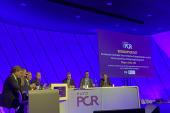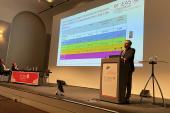Solid 2-Year Data With ‘Unlocking’ Coronary Stent: BIOADAPTOR RCT
It’s not quite a stent and not quite a scaffold—either way, the device was associated with low rates of TLF over follow-up.

PARIS, France—A novel “unlocking” coronary device shows excellent performance out to 2 years when used in patients with de novo coronary lesions, with the rate of target lesion failure essentially unchanged over time and better than that of the contemporary drug-eluting stent used as comparator, according to a study presented at EuroPCR 2024.
As previously reported by TCTMD, the DynamX Bioadaptor (Elixir Medical) serves as an arterial scaffold early post-PCI, allowing for plaque stabilization and antiproliferative drug delivery, but then disconnects over time, allowing normal vessel function to return.
At 2 years in BIOADAPTOR RCT, the rate of TLF was 2.3% in the patients treated with the device versus 5.5% in those treated with a zotarolimus-eluting stent (HR 0.41; 95% CI 0.14-1.16). One-year outcomes, which were presented last year, showed that Bioadaptor was noninferior for the primary endpoint of TLF when compared with Resolute Onyx (Medtronic).
“With first- and second-generation DES, we see an increase of [stent-related] adverse events every year, around 2% to 3%,” lead investigator Stefan Verheye, MD, PhD (ZNA Cardiovascular Center Middelheim, Antwerp, Belgium), told TCTMD. “So, it’s important to see what’s happening between 1 and 2 years. Now, every year is going to be important to see if we see that increase, but it's not the case [at this point]. There's just a flat line.”
With Resolute Onyx, which Verheye said is a “very good stent,” the rate of TLF appears to be accruing over time, with the 2-year rate in line with expectations based on prior studies.
Robert Byrne, MBBCh, PhD (Mater Private Network, Dublin, Ireland), who was part of the EuroPCR hotline session devoted to new coronary devices, said the 2-year data look encouraging, though he urged caution when interpreting secondary analyses conducted at later follow-up. Still, said Byrne, the study suggests “an edge” with Bioadaptor in terms of TLF over the drug-eluting stent.
“The [event] curves continue to separate, which suggests some benefit over time, but it’s surprising because it’s difficult to best newer-generation DES technology as we saw from a number of studies at EuroPCR,” he told TCTMD.
Similarly, Mirvat Alasnag, MD (King Fahd Armed Forces Hospital, Jeddah, Saudi Arabia), one of the discussants during the session, hailed the technology as promising.
“We've sort of plateaued with drug-eluting stents in terms of what we're achieving,” she told TCTMD. “No matter how much better the platforms are getting, or the stent strut thickness is getting thinner and thinner, I think we're pretty much plateaued with all platforms in terms of target lesion failure rates and revascularization rates. It is going to need that we think slightly outside the box, to do something a little more different.”
Excellent 2-Year TLF Rates
The DynamX Bioadaptor lands somewhere between a coronary stent and a bioresorbable scaffold: it has three helical, sirolimus-eluting, sinusoidal strands of cobalt-chromium that are temporarily locked together by a thin PLLA-bioresorbable polymer. As the polymer is resorbed over 6 months, the scaffold disconnects, allowing the vessel to function normally while also maintaining some support with the disengaged metallic strands.
Initially, said Verheye, the device behaves like a normal stent, “and then you have this unlocking, which allows the Bioadaptor to have a dynamic profile [within] the vessel.” Imaging data have demonstrated restored vessel compliance and improved pulsatility when compared with the traditional DES.
Patients in BIOADAPTOR RCT were enrolled in Germany, Belgium, New Zealand, and Japan. The majority of the study’s 445 patients had hypertension and dyslipidemia, while one-quarter had diabetes mellitus. Approximately 40% of patients had undergone prior revascularization. The target vessel in roughly 50% of patients was the LAD, and a little more than one in five lesions were bifurcations.
While there was a 59% relative reduction in TLF in the primary intention-to-treat analysis, the benefit was even more pronounced in the per-protocol analysis, with a TLF rate of 1.9% with Bioadaptor versus 5.5% with Onyx (P = 0.046 for superiority). Target-vessel failure in the per-protocol analysis was also lower with the new device (1.9% vs 6.0%; P = 0.029 for superiority). In LAD lesions, the TLF rate in the per-protocol analysis was 1.9% with Bioadaptor versus 8.7% with Resolute Onyx (P = 0.028 for superiority). While the number of patients with small vessels or long lesions was small, there were no reported TLF events in those treated with Bioadaptor in those subgroups.
Verheye said the total absence of stent-related adverse events accruing between years one and two is noteworthy. “Everybody thinks we have very good devices and we do have very good devices, but then look at what the results are at, say, 5 years and later and you see that [stent-related adverse events] are just increasing,” he said.
As for how he imagines the device being used—it has CE Mark approval but is not cleared for use in the US—Verheye said “just about everywhere,” as long as the data continue to look good. He highlighted the advantage in patients with LAD lesions, noting that the benefit was quite pronounced in this subset. As for deliverability, it behaves just like a normal stent, he said.
Caution Still Warranted
To TCTMD, Byrne said the accrual of stent-related events is a real phenomenon with current DES—they’ve observed this in long-term follow-up of the ISAR-4 and ISAR-5 studies. But Byrne expressed some skepticism as to how use of the Bioadaptor might translate into a reduction in TLF.
“I wouldn't have thought that restoring pulsatility alone would be such a game changer that you would see a big difference in TLF,” he said. “If you dig into the data a little bit, you’ll see that it’s driven by a relatively large numerical difference in cardiovascular death. It’s hard to believe that stent A versus stent B could result in a difference in cardiovascular death. We can’t show that with angioplasty versus medical treatment in many settings.”
There were also numerical differences in target-vessel MI and clinically driven target lesion revascularization. At least with TLR, Byrne said its plausible that a device that “moves with the vessel would be less of a nidus for restenosis”
Alasnag also urged caution, pointing out that differences showing superiority were seen only in the per-protocol analysis. As for the link between improved pulsatility and reduced TLF, Alasnag pointed to lessons learned in the bioabsorbable stent studies with regard to optimize scaffold delivery. She suspects good implantation techniques, which were strongly encouraged—plaque modification and pretreatment, along with appropriate sizing and postdilatation—were a contributing factor here. “Operators were just more cognizant of appropriate sizing and stent optimization,” Alasnag said.
On the whole, Byrne said Bioadaptor “is something to keep an eye on.” It’s early technology, and they’ll need more data on how well the device performs in challenging patients. For approval, studies won’t necessarily need to show superiority given that the field has a good handle on what outcomes should be, but to make any claim of superiority over DES will require a large-scale randomized trial, he said.
Alasnag agreed, noting it would be ideal to see the device used in a broader patient population, such as those with more bifurcation lesions and chronic kidney disease, among other characteristics.
Michael O’Riordan is the Managing Editor for TCTMD. He completed his undergraduate degrees at Queen’s University in Kingston, ON, and…
Read Full BioSources
Saito S, on behalf of the BIOADAPTOR investigators. Randomized controlled trial of sirolimus-eluting bioadaptor versus zotarolimus-eluting stent. Presented at: EuroPCR 2024. May 14, 2024. Paris, France.
Disclosures
- Saito reports consulting fees from Elixir Medical and Medinol and honorarium from Abbott Medical.
- Verheye reports honoraria/consulting from Elixir Medical and Shockwave Medical.
- Byrne reports grant research from Abbott Medical, Biosensors, Boston Scientific, and Translumina.
- Alasnag reports no conflicts of interest.





Comments